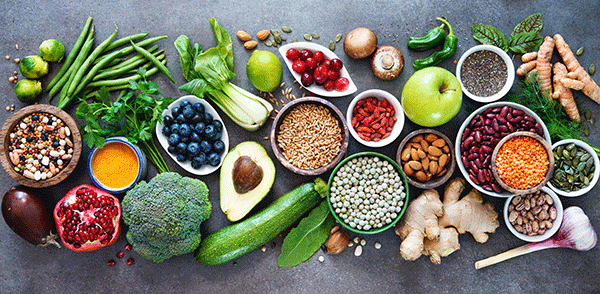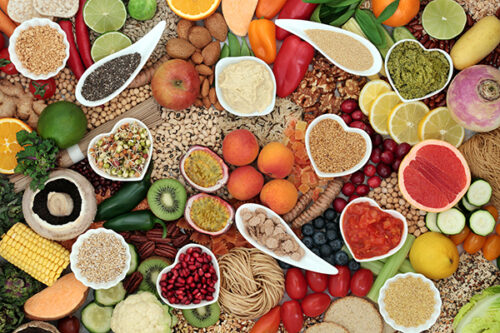The Calorie Density Approach to Nutrition and Lifelong Weight Management

By Jeff Novick, MS, RDN
Calorie density is the simplest approach to healthful eating and lifelong weight management. This commonsense approach to sound nutrition allows for lifelong weight management without hunger and more food for fewer calories. It’s also easy to understand and follow. In addition, by following the principles of calorie density, you will also increase the overall nutrient density of your diet. The basic principles of calorie density are simple and outlined below. Remember, these are just guidelines expressing the principles and not exact recommendations.
The Calorie Density Approach
Calorie density is simply a measure of how many calories are in a given weight of food, most often expressed as calories per pound. A food high in calorie density has a large number of calories in a small weight of food, whereas a food low in calorie density has much fewer calories in the same weight of food. Therefore, one can consume a larger portion of a low-calorie dense food than a high-calorie dense food for the same number of calories. On a day-to-day basis, people generally eat a similar amount of food, by weight. Therefore, choosing foods with a lower calorie density allows us to consume our usual amounts of food (or more) while reducing our caloric intakes and vice versa.
Foods low in calorie density also tend to be higher in satiety. So, by consuming foods lower in calorie density, one can fill up on much fewer calories without having to go hungry and without having to weigh, measure or worry about portion control. In addition, the foods that are lower in calorie density (fruits, veggies, starchy vegetables, intact whole grains and legumes) are also the foods highest in nutrient density. Therefore, by following a diet lower in calorie density, one also automatically consumes a diet higher in nutrient density.
The Principles of Calorie Density for Maximum Weight Loss
Hunger and Satiety – Eat only when you are hungry and until you are comfortably full. Avoid starving or stuffing yourself.
Meal Sequence – Start all meals with a salad, soup and/or fruit. That will allow you to fill up with foods that are the lowest in calorie density.
Liquid Calories – Chew your calories and avoid drinking or liquifying them. Liquids do not fill you up as much as solid foods of equal calories.
Dilution Is the Solution (the 50/50 guideline) – Dilute the calorie density of your meals by filling half of your plate (by visual volume) with non-starchy vegetables and/or fruit and the other half with starchy vegetables, intact whole grains and/or legumes.
Vegetables vs. Fats – Non-starchy vegetables are the lowest in calorie density while fat and oil are the highest. Adding non-starchy vegetables to any dish will lower the overall calorie density of a meal, while adding even small amounts of fat and/or oil will raise its overall calorie density.
Calorie-Dense Foods – Limit/Avoid calorie-dense foods which include dried fruit, high-fat plant foods (nuts, seeds, avocados) and some processed whole grains (bread, bagels, crackers, dry cereal, tortilla, puffed cereals, popcorn). If used, incorporate these foods into meals that are made up predominately of low-calorie-dense foods.
The Calorie Density Scale
| Foods | Calories/Pound |
| Vegetables | 60 – 195 |
| Fruit | 140 – 420 |
| Potatoes, Pasta, Rice, Barley, Yams, Corn, Hot Cereals | 320 – 630 |
| Beans, Peas, Lentils (cooked) | 310 – 780 |
| Breads, Bagels, Fat-free Muffins, Dried Fruit | 920 – 1,360 |
| Sugars (i.e. sugar, honey, molasses, agave, corn syrup) | 1,200 – 1,800 |
| Dry Cereals, Baked Chips, Fat-free Crackers, Pretzels, Popcorn | 1,480 – 1,760 |
| Nuts/Seeds | 2,400 – 3,200 |
| Oils | 4,000 |
Research has shown that people can eat freely of foods that are about 300-400 calories per pound or less and not gain weight. People can consume relatively large portions of foods that are between 400 and 800 calories per pound and still lose or maintain their weight depending on their individual activity levels and metabolism. The intake of foods with a calorie density of 800-1,800 should be limited as these can contribute to weight gain and interfere with efforts to lose weight. Additionally, the intake of foods over 1,800 calories per pound should be extremely limited as these foods can very easily contribute to weight gain and obesity and can also greatly interfere with efforts to lose weight.
The 2007 report from the American Cancer Institute and the World Cancer Research Fund recommended lowering the average calorie density of the American diet to 567 calories per pound. One can easily do this by following the above principles of calorie density, which allow us to eat freely of unrefined, unprocessed fruits, veggies, starchy veggies, and intact whole grains and legumes, without the addition of salt, sugar and/or fat/oil to them.
Summary
Calorie density really is a common-sense approach to sound nutrition and is the cornerstone of good health. It is the simplest way to lose and/or manage your weight for life. By following a few simple principles, you will increase the amount of food on your plate while decreasing your overall caloric intake, all without ever having to go hungry. At the same time, you will be optimizing your overall nutrient intake.
Recommended Articles

A Lesson in Nutrition

Recipes from the June 2008 Newsletter







